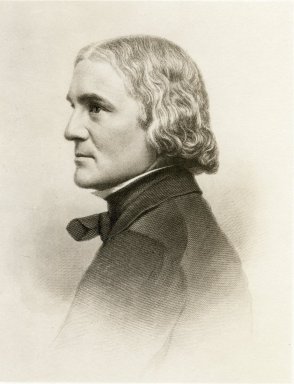History and Milestones
(from “Friends, Past and Present: A Rich Legacy” by Micheline Jedrey; Friends of the Wellesley College Library Newsletter, Fall 2005.)
Henry Fowle Durant (pictured to the right) was the first great friend of the library. In 1875, he donated 8,000 selected volumes from his private collection to found the Wellesley College Library. Until his death in 1881, he combed the world’s book markets in the interest of his college.
Early on, the “friends” of the library were not an organized group, but rather Mr. Durant’s friends. Many were wealthy collectors who were very supportive of the College during his lifetime and, importantly, after his death. Some donated books, while others made monetary gifts. Prominent among them was Harvard Professor Eben N. Horsford, an engineer and analytical chemist who invented baking powder. Professor Horsford provided valuable books and also founded the Library Permanent Fund for the purchase of texts needed to support the curriculum. The fund still exists, providing income for a wide selection of purchases each year.
The donation of personal collections also contributed to the richness of the Library. In 1904, Mr. George A. Plimpton donated 1,200 volumes of Italian manuscripts and books from the 14th through 18th centuries. In 1920, Charles Eliot Goodspeed, the legendary Boston bookseller, donated his personal Ruskin collection. Perhaps the most avid early patron and advocate for the Library, however, was Harvard Professor George Herbert Palmer, husband of Wellesley’s second president, Alice Freeman Palmer. His generosity is epitomized by his gift, in 1924, of more than 3,000 volumes of the English poets. Professor Palmer continued to add to the collection, inspiring others to do likewise. Caroline Hazard, Wellesley’s fifth president, funded the purchase of the complete set of the Brownings’ love letters and Katherine Lee Bates donated her personal library. When Professor Palmer died in 1933, the Friends of the Wellesley College Library was organized to carry on the work he had championed. This group undertook the task of identifying benefactors to donate money and/or notable collections and to help purchase items identified by the College Librarian. They supported exhibits, held programs, and produced a newsletter. This group added many notable volumes until it disbanded in 1954, when the College requested that all donations to Wellesley be channeled toward general purposes. Annis Nan Nuys Schweppe, Class of 1903, provided funds to establish the Book Arts Laboratory in 1944 for the practice of printing and bookmaking, and, in 1948, she donated a large collection of fine press books and ephemera produced by Edwin and Robert Grabhorn, printers considered by many to be among the best of the 20th century.
In the spring of 1982, Eleanor Gustafson, College Librarian, recommended to President Keohane that the Friends of the Library (FOL) be reestablished. Since its rebirth in 1984, the FOL have followed the lead of their predecessors, raising money through membership and special contributions to support the Library in ways not provided for by the college budget. We plan programs, support exhibitions, and, through our newsletter, inform our membership of new developments as the Library rises to meet the challenges of the digital age and information accessibility.
The business of the FOL is conducted under the aegis of its Steering Committee and its projects have taken many forms. Recent examples include donations totaling $500,000 to support the creation of the Conservation Facility and the restoration of the Sanger Room, funds for the purchase of limited edition books for the Art and Music Libraries, an oversize printer to allow special graphic presentations for student research, books for newly developing areas of the curriculum, and, in conjunction with the 2005 Artists’ Books Conference, underwriting the cost of a catalog that exhibits some of Wellesley’s remarkable collection.
The legacy of the Friends of the Library is rich, originating with the founding of Wellesley College. We are still motivated by the same goals set by Durant 130 years ago – to maintain the Library as the dynamic center of the College by preserving the past and supporting its growth.
